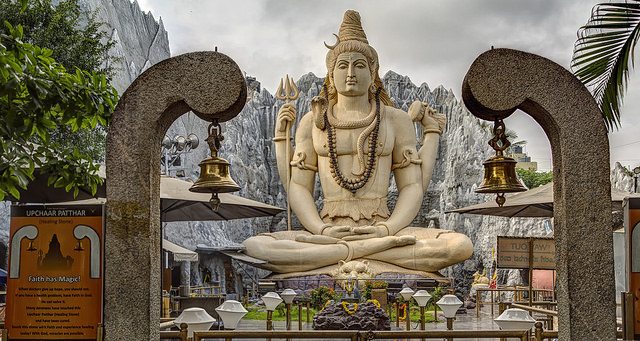
It is my belief that if a belief system is not harming others, people have a natural right to express themselves as they wish and embrace the spiritual path they choose.
Many of us even support people following paths different from our own—I know I do.
Recently, I was saddened to hear that the middle and upper-classes of India no longer respect wandering sadhus, or the yogi-ascetics who have renounced the worldly life as a practice of spiritual discipline. These people are now disparaged as beggars by most of the country.
The sadhus have a history older than India itself. They live a hard life—a begging bowl and a water pot often their only possessions.
They travel alone or in groups from holy site to holy site, setting up camps along the way to practice meditation and devotional exercises.
No matter how fierce the conditions—scorching heat in the desert, or heavy snows in the Himalayas—they wear but a single layer of ochre cloth or go completely naked, barefoot, protected only by the ash they smear on their body. The ground is their bed, the sky is their blanket, and whichever herbs they can gather is their medicine.
Worshippers of Shiva, their life is disciplined and austere.
There was a time in India when making a food offering to a sadhu was viewed positively. People would kneel before them and touch their feet, perhaps dropping a coin in their bowl and requesting a prayer.
Things are different now. My friend and Indian historian, Krishnakant Shukla, explained to me how deeply disturbed he was that the elite in India, including his parents, no longer respected the sadhus, and in fact disrespected them and failed to support them.
Of course, not all sadhus are holy men—maybe only a few have attained realization, but they work hard to pursue their path. They may not have reached the end of it, but they are following it nonetheless.
Sadhus undergo great austerities, spend hours in prayer and meditation each day, and ideally transfer the merit from all their efforts to you and me and for the betterment of humanity.
Regardless of whether we believe this method is effective or not, it is the belief of a good many of our brothers and sisters—and as such, should be respected. We expect the same for our own beliefs, so why should we not offer the same to others? Who are we, from the comfort of our homes and every indulgence at our fingertips, to criticize those enduring such hardships and austerities for our sake?
Whether we have ever heard of the sadhus or not isn’t important; the above example is only given to illustrate a point: we need to be open and accepting of other people’s viewpoints and traditions.
If we spend our time judging and condemning others, without even taking the time to understand those we criticize, we are indeed acting foolishly. If we respect and honor others, we are respecting and honoring ourselves, because we are all part of a global humanity.
Being respectful does not mean we should accept all traditions for ourselves. It means that, at the very least, we should honor the decisions of others, and if we disagree, do so in a constructive way.
The 5,000-year-old sadhu tradition is rapidly becoming extinct, and when it does, India will have lost a cornerstone of its cultural heritage.
Sadly, the sadhus have plenty of company, as modernity continues to attract the heirs of irreplaceable traditions away from their family’s heritage that often goes back thousands of years. In Nepal, for example, the art of Buddhist ritual dance has all but died out because the new generation is lured away from following in the footsteps of their community members by the promise of modern education.
When the elders pass away and their history is not passed along and kept alive, we, as a people, lose something that cannot be replaced.
It is important that we participate in aiding cultural survival in whatever capacity we can.
If we are the inheritors of a particular skill, we should think twice before being lured away from what brought great happiness and honor to our ancestors and their communities. If we are not so positioned to actively carry on in the footsteps of those before us, we can play a passive role and support the ancient arts through donations, attending performances, or purchasing crafts. We have World Heritage Sites that have been created to preserve temples, stupas, coliseums, statues, and more.
There is no reason that we as individuals and communities should not make it a priority to support, according to our capacity, the people, trades, and crafts that have endured from ancient times ’til today.
Let us not forget the people who have, either directly or indirectly, played their part in making our cultures so diverse and interesting.
Let us not allow ourselves to disregard our social treasures, as India has done her sadhus.
Authors note: There is a wonderful documentary available on the life of a sadhu, one of the few that portrays their lives without inaccuracy, sensationalism, or dismissiveness. The film was done by a Buddhist nun who lived an entire year with a sadhu as he wandered by foot, naked, from the deserts of the southern tip of India to the high Himalayan glacial peak, wearing nothing but ash. The film, Naked in Ashes, is the only one this author knows about that tells their story accurately and with sensitivity to the subject.
~
~
Author: Richard Josephson
Image: John Hoey/Flickr
Editor: Callie Rushton
Copy Editor: Travis May
Social Editor: Yoli Ramazzina






Read 0 comments and reply